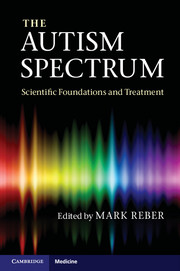Book contents
- Frontmatter
- Contents
- List of Abbreviations
- List of Contributors
- Preface
- Section 1 What We Know about Autism and How We Know It
- Section 2 Assessing and Treating Children with Autism Spectrum Disorders
- Section 3 Assessing and Treating Adults with Autism Spectrum Disorders
- Chapter 12 Diagnosis and assessment of adults with ASDs
- Chapter 13 Service and treatment planning for adults with ASDs
- Index
- Plate Section
- References
Chapter 12 - Diagnosis and assessment of adults with ASDs
from Section 3 - Assessing and Treating Adults with Autism Spectrum Disorders
Published online by Cambridge University Press: 05 November 2012
- Frontmatter
- Contents
- List of Abbreviations
- List of Contributors
- Preface
- Section 1 What We Know about Autism and How We Know It
- Section 2 Assessing and Treating Children with Autism Spectrum Disorders
- Section 3 Assessing and Treating Adults with Autism Spectrum Disorders
- Chapter 12 Diagnosis and assessment of adults with ASDs
- Chapter 13 Service and treatment planning for adults with ASDs
- Index
- Plate Section
- References
Summary
Introduction
Most early studies of Autism Spectrum Disorders (ASDs) in developed countries had prevalence estimates that were just short of 60 per 10 000 (Baird et al., 2000; Bertrand et al., 2001; Chakrabarti and Fombonne, 2005), with the prevalence of Autistic Disorder (AD) between 10 and 20 per 10 000. However, a study of 55 000 British 8- and 9-year old children suggested an ASD prevalence that may be as high as 110 per 10 000 (Baird et al., 2006). More recently, the US Centers for Disease Control and Prevention indicated that ASDs affect 1 in 88 children, including 1 in 54 boys (Autism and Developmental Disabilities Monitoring Network, 2012). In Canada, the prevalence has been reported to be 1 in 165 (Fombonne, 2003) and in the UK 1 in 110 (Wing and Potter, 2002). Adequate explanations for this increase in prevalence have not been delineated to date, but may involve an actual increase in ASD cases as well as an apparent increase secondary to improved diagnostic instruments and earlier detection. What is clear is that children with ASDs become adults with ASDs. As they age, their symptoms and disabilities do not go away, but rather new environmental challenges await them. The young adult’s ability to meet these new challenges can be enhanced through careful individualized assessment of adult developmental needs and functional strengths, coupled with delineation of a habilitation plan that seeks to maximize the individual’s strengths (as opposed to a limited clinical focus solely on a person’s disabilities).
- Type
- Chapter
- Information
- The Autism SpectrumScientific Foundations and Treatment, pp. 285 - 304Publisher: Cambridge University PressPrint publication year: 2012



